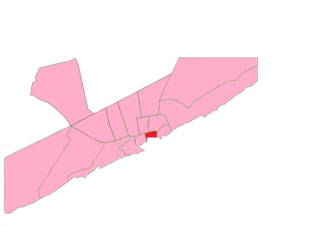
Swahili, also known by its local name Kiswahili, is a Bantu language originally spoken by the Swahili people, who are found primarily in Tanzania, Kenya and Mozambique. The number of current Swahili speakers, be they native or second-language speakers, is estimated to be over 200 million, with Tanzania known to have most of the native speakers.
Spirit possession is an unusual or an altered state of consciousness and associated behaviors which are purportedly caused by the control of a human body and its functions by spirits, ghosts, demons, angels, or gods. The concept of spirit possession exists in many cultures and religions, including Buddhism, Christianity, Haitian Vodou, Dominican 21 Divisions, Hinduism, Islam, Wicca, and Southeast Asian, African, and Native American traditions. Depending on the cultural context in which it is found, possession may be considered voluntary or involuntary and may be considered to have beneficial or detrimental effects on the host. Spirit possession is often regarded as a reason in support of spirits, deities or demons. In a 1969 study funded by the National Institute of Mental Health, spirit possession beliefs were found to exist in 74% of a sample of 488 societies in all parts of the world, with the highest numbers of believing societies in Pacific cultures and the lowest incidence among Native Americans of both North and South America. As Pentecostal and Charismatic Christian churches move into both African and Oceanic areas, a merger of belief can take place, with demons becoming representative of the "old" indigenous religions, which the Christian ministers attempt to exorcise.
The Swahili people comprise mainly Bantu, Afro-Arab and Comorian ethnic groups inhabiting the Swahili coast, an area encompassing the Zanzibar archipelago and mainland Tanzania's seaboard, littoral Kenya, northern Mozambique, the Comoros Islands and Northwest Madagascar.

Bagamoyo is a historic coastal town and capital of Bagamoyo District in the Pwani Region of Tanzania. Much of the settlement was founded at the end of the 18th century, though it is an extension of a much older Swahili settlement, Kaole. It was chosen as the capital of German East Africa by the German colonial administration and it became one of the most important trading ports for the Germans along the East African coast along the west of the Indian Ocean in the late 19th and early 20th century. Bagamoyo lies 75 kilometres north of Dar-es-Salaam on the coast of the Zanzibar Channel, across from the island of Zanzibar. The town hosts Bagamoyo Historic Town, that is a National Historic Site of Tanzania. In 2011, the town had 82,578 inhabitants.

Pangani District Council is one of eleven administrative districts of Tanga Region in Tanzania. The District covers an area of 1,756 km2 (678 sq mi). It is bordered to the north by Muheza District, to the east by Zanzibar Channel, to the south by the Chalinze District of Pwani Region, and to the west by the Handeni District. The district is comparable in size to the land area of Guadeloupe. The district seat (capital) and largest settlement in Pangani district is the town of Pangani. The district is named after the historic Pangani River. As of the 2022 census, the population was Pangani district was 75,642, making it the least populous district in Tanga Region.
The Zaramo people, also referred to as Dzalamo or Saramo, are a Bantu ethnic group native to the central eastern coast of Tanzania, particularly Dar es Salaam Region and Pwani Region. They are the largest ethnic group in and around Dar es Salaam, the former capital of Tanzania and the 7th largest city in Africa. Estimated to be about 0.7 million people, over 98% of them are Muslims, more specifically the Shafi'i school of Sunni Islam. Zaramo people are considered influential in Tanzania popular culture with musical genres like Sengeli originating from their commonity in Kinondoni District. Their culture and history have been shaped by their dwelling in both urban and rural landscapes.

Pate (Paté) Island is located in the Indian Ocean close to the northern coast of Kenya, to which it belongs. It is the largest island in the Lamu Archipelago, which lie between the towns of Lamu and Kiunga in the former Coast Province. The island is almost completely surrounded by mangroves.
Afro-Arabs, African Arabs, or Black Arabs are Arabs of full or partial indigenous African descent. These include primarily minority groups in the United Arab Emirates, Yemen, Saudi Arabia, Oman, Kuwait, Qatar, and Bahrain, as well as Iraq and Levant: Syria, Palestine, and Jordan. The term may also refer to various Arab groups in certain African regions.

The Nunda, Eater of People is an abridged version of a Swahili fairy tale titled "Sultan Majnun", collected by Edward Steere (1828–1882) in Swahili Tales, as told by natives of Zanzibar (1870). Andrew Lang included it in The Violet Fairy Book (1901).

The Kizimkazi Dimbani Mosque is a mosque Located in the town of Dimbani, Kusini District of Unguja South Region in Tanzania. It is situated on the southern tip of the island of Zanzibar in Tanzania and is one of the oldest Islamic buildings on the East African coast. Despite its name, it is located in Dimbani, not Kizimkazi, which is 3 miles away. According to a preserved kufic inscription, it was built in 1107. Although the inscription and certain coral-carved decorative elements date from the period of construction, the majority of the present structure was rebuilt in the 18th century.

The Swahili coast is a coastal area of East Africa, bordered by the Indian Ocean and inhabited by the Swahili people. It includes Sofala ; Mombasa, Gede, Pate Island, Lamu, and Malindi ; and Dar es Salaam and Kilwa. In addition, several coastal islands are included in the Swahili coast, such as Zanzibar and Comoros.
The Shirazi also known as Mbwera, are a Bantu ethnic group inhabiting the Swahili coast and the nearby Indian ocean islands. They are particularly concentrated on the islands of Zanzibar, Pemba and Comoros.

Bantu religion is the system of beliefs and legends of the Bantu people of Africa. Although Bantu peoples account for several hundred different ethnic groups, there is a high degree of homogeneity in Bantu cultures and customs, just as in Bantu languages. Many Bantu cultures traditionally believed in a supreme god whose name is a variation of Nyambe/Nzambe.

Shangani District is a district in the southeastern Banaadir region of Somalia. It lies in central Mogadishu. Shingani along with Hamar Weyne are the oldest districts in Mogadishu. Shangani means On the sand in Swahili, as this district was originally a Benadir settlement.

The Bantu peoples are an ethnolinguistic grouping of approximately 400 distinct native African ethnic groups who speak Bantu languages. The languages are native to 24 countries spread over a vast area from Central Africa to Southeast Africa and into Southern Africa.
A Swahili door or Zanzibari door is a door that was developed in the Swahili coast during the Middle Ages and peaked in the 19th century. The door is usually the first and foremost key element of Swahili architecture and was the historically first item that was built before the rest of the home.
Shamiani is protected historic site located inside Mkoani District of Pemba South Region in Tanzania. The site is home to partially excavated abandoned medieval Swahili ruins with a brief occupation period from about 14th to 16th century.

Msuka Mjini Ruins is protected historic site located inside Micheweni District of Pemba North Region in Tanzania. Msuka Mjini has a Swahili mosque from the fifteenth century preserved in ruins on the Kigomasha peninsula on the island. The date 816AH is carved on the interior of the circular mirhab.

Kunduchi is a Medieval Swahili National Historic Site located in Kunduchi ward, located in Kinondoni District of Dar es Salaam Region in Tanzania. There is an excavated 15th-century mosque on the site. An 18th-century cemetery with the biggest collection of pillared tombs in East Africa, situated in a baobab woodland, and embellished with Ming era's porcelain plates. The pottery discovered here demonstrates the medieval town's affluence and trading connections with imperial China.

Bagamoyo Historic Town or Bagamoyo Stone Town, is the historic section of Bagamoyo town in Bagamoyo District of Pwani Region. Due to its historic significance spanning centuries and empires, Old Bagamoyo is a National Historic Site of Tanzania. The settlement was first inhabited in the 8th century as a Zaramo village and then a Swahili stone settlement, satellite to Kaole. One of the most significant trading hubs on the coast of East Africa, Bagamoyo served as the last halt for ivory caravans making their way on foot from Lake Tanganyika to Zanzibar.












